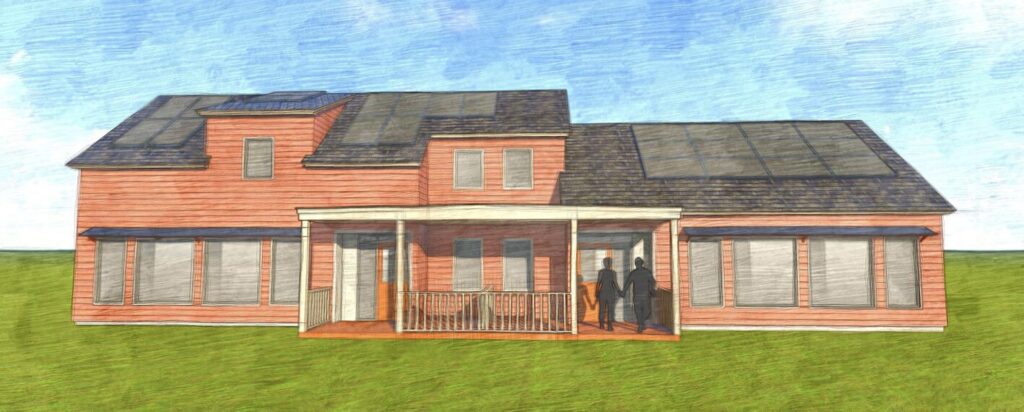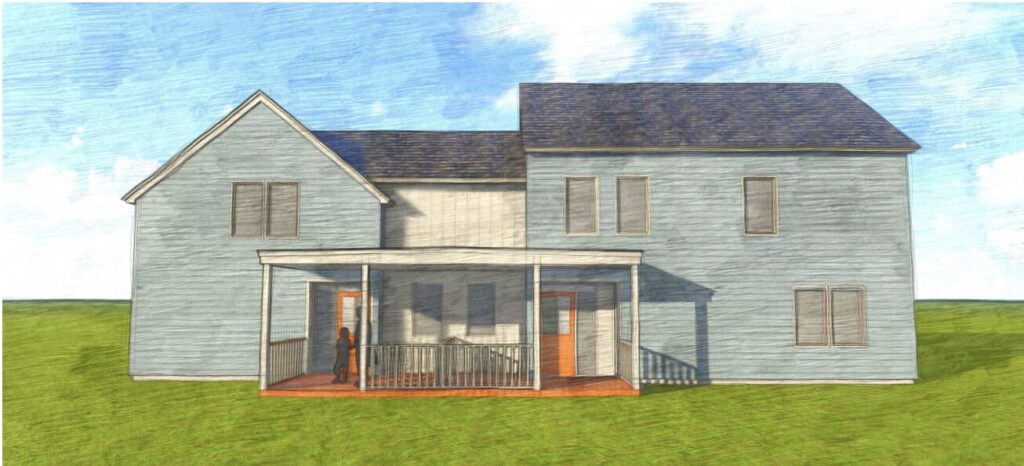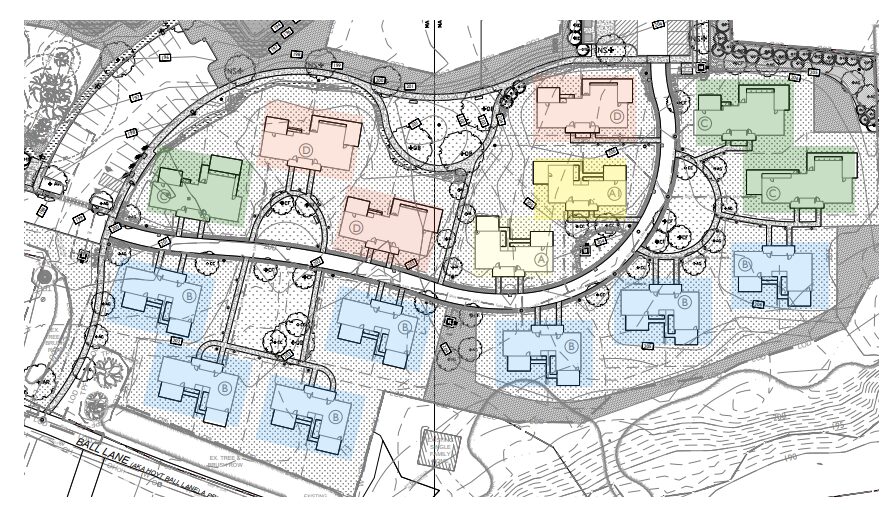Should Amherst Residents Get Priority for Purchase of Ball Lane Affordable Homes?

Architect's rendering of duplex at Amherst Community Homes, the affordable housing development proposed for Ball Lane. Photo: amherstma.gov
Report on the Meeting of the Amherst Zoning Board of Appeals, December 21, 2023
This meeting was held over Zoom and was recorded. It can be viewed here.
Present
Steve Judge (Chair), Everald Henry, Philip White, and Craig Meadows. Associate member Hilda Greenbaum.
Staff: Rob Watchilla (Planner), Chris Brestrup (Planning Director), and Carolyn Murray (Town Attorney)
The Zoning Board of Appeals (ZBA) continued its discussion of the Comprehensive Permit application by Valley CDC to construct 30 affordable duplexes off of Ball Lane in North Amherst. The discussion at this meeting was largely devoted to how the condominium association for the project would function and whether local preference would be used to select the buyers of the duplexes.
Valley CDC is constructing the duplexes under the Commonwealth Builders program of MassHousing, whose primary aim is to increase homeownership among minority populations and to decrease the race-based wealth gap in Massachusetts. This principle guides the selection of applicants, although race cannot be used as a factor, according to Fair Housing Law. Ten of the units are reserved for those making 80% of area mean income (AMI) ($83,750 for a family of four) and 20 units for those making 100% of AMI ($104,700 for a family of four). Applicants must be first-time homebuyers, have sufficient resources for a down payment and to qualify for a conventional mortgage, and attend a first-time homebuyer class from Valley CDC.

ZBA member Everald Henry worried that many people in the target population would not qualify due to poor credit scores or lack of funds for a down payment, and suggested that the qualifications be more flexible. Valley CDC Project Manager Jessica Allan said that Valley CDC Homeowner Coordinator Donna Cabana knows many ways to help applicants qualify for a mortgage. She suggested that those interested in purchasing one of these duplexes contact Cabana soon, so there will be time to increase their credit scores and pay down their debt. Valley CDC does not want applicants to fall prey to predatory lending, so requires that applicants qualify for conventional mortgages. Henry was still skeptical that a single parent would have the extra income to pay off debts and increase their credit score.
The project will be set up as a condominium development with a homeowners’ association and condo fees, but the homeowners will not be permitted to pay more than 30% of their income for housing, which includes mortgage costs, property tax, and fees. Valley CDC is hoping to keep the condo fees to $300 per month or less. Valley will initially supply the three managers for the condo board, but they will be replaced by residents as the duplexes are occupied.

The sale price of the 80% AMI units is restricted for 30 years. The 100% units may be sold at market rate after 15 years, but 50% of the profit must be given to the town, which has devoted funding to the development, to be used for housing. The units must be owner-occupied, but can be deeded over to family members, even if those members exceed the income requirements, because one of the goals of the project is to increase intergenerational wealth.
Applicant Selection Process
Although Fair Housing law prevents race being used as a selection criterion for the purchasers of the duplexes, the Commonwealth Builders Program gives preference to “Disproportionately Impacted Households” (DIH). As defined by the U.S. Treasury, this includes:
1. Low-income households defined as those with:
♣ Income at or below 185% of the Federal Poverty Guidelines for the size of its household
♣ Income at or below 40% of AMI
2. Households residing in qualified census tracts
3. Households that qualify for certain federal benefits:
♣ Temporary Assistance for Needy Families (TANF)
♣ Supplemental Nutrition Assistance Program (SNAP)
♣ Free and Reduced-Price Lunch (NSLP) and/or School Breakfast (SBP) programs
♣ Medicare Part D Low-income Subsidies
♣ Supplemental Security Income (SSI)
♣ Head Start and/or Early Head Start
♣ Special Supplemental Nutrition Program for Women, Infants, and Children (WIC)
♣ Section 8 Vouchers
♣ Low-Income Home Energy Assistance Program (LIHEAP)
♣ Pell Grants
If the ZBA decides it wants to give preference to people who live or work in Amherst or who have children in the Amherst schools, that preference would only apply to the 10 units being sold to those making 80% of AMI. And because, by MassHousing policy, no more than 70% of the units can be reserved for local preference, a maximum of seven units would be limited to Amherst residents.
Allan, of Valley CDC, assumed that the DIH criteria would comprise the first screening for applicants. Because Amherst is part of the Springfield Metropolitan Service Area (MSA), the pool of non-white local applicants must “equal or exceed the non-white households of the Springfield MSA.” If there are too few non-white local applicants in the local applicant pool, there may need to be a preliminary lottery to make the pool consistent with the demographics of the MSA. If the ZBA prefers local preference in the selection process, it must provide written justification to Mass. Housing. CHAPA (Citizen Housing and Planning Association) is the nonprofit that will monitor the compliance of the project with requirements under State Chapter 40B and handle any resale of units.
Questions Exist about Local Preference
MassHousing and Valley CDC prefer that the ZBA not give preference to applicants who live or work in Amherst. ZBA member Henry agreed, noting that Amherst is a predominantly white town and one of the main goals of this project is to increase BIPOC homeownership.
However, the local preference option seemed to appeal to the majority of the board. Greenbaum noted that Amherst, Hadley, and Northampton continue to build affordable housing at the expense of local property tax payers, while other communities, such as South Hadley and Ludlow do not. She felt it was unfair for residents of those communities to be able to buy a house in Amherst, while those already living here cannot. She also pointed out that a majority of students in the Amherst schools are non-white, so there are many BIPOC families who reside in Amherst.
ZBA chair Steve Judge stated that many people who work in Amherst commute from nearby towns, even from Springfield, and would be eligible to be considered under local preference. He did not think choosing local preference would preclude having a diverse applicant pool.
Planning Director Chris Brestrup said that about 30% of Amherst residents live in one of two qualified census tracts. Of those living in the North Amherst census tract, 8% are Black, 4% Hispanic, and 9% Asian. In the central Amherst census tract, 12% are Hispanic. District 1 Town Councilor Cathy Schoen said that the population of Amherst’s elementary schools is 11% Black, 24% Hispanic, and 12% Asian. She suggested one way of informing BIPOC residents about the project is through the Black churches in town.
Judge raised concerns that parents of college students would purchase the units for their children to live in while attending UMass. He said, “This is a unique Amherst problem” that members of Valley CDC and MassHousing had not had to consider in previous projects. Kathleen Evans of MassHousing thought it was possible to use the lottery and promotion of the project to avoid this situation, but unlike affordable housing rental situations, students cannot be expressly prohibited.
Greenbaum asked if an Amherst resident who qualified under the DIH standard would be counted under local preference as well. There were also questions about how a preliminary lottery pool for local applicants would be conducted. Valley CDC and MassHousing representatives said they would try to get answers to the questions. Greenbaum also wanted to know how property taxes would be assessed for the units; because their resale value is restricted, the tax cannot be based on sales of similar properties, and the town does not know what sales prices MassHousing will set. Brestrup said she would check with the assessor’s office.
The discussion of property taxes and a continuation of who will have what level of preference for the units will be on the agenda for the January 4 ZBA meeting.
Total Project Cost Is Over $16 Million
Even though the units will be small (995-1250 sq.ft) and even with the economies of scale of building 30 units, this is a very expensive project. The 30 duplexes are expected to cost about $645,000 apiece. Commonwealth Builders is giving $250,000 per unit in subsidies. MassHousing is contributing $2 million in site fees. The Town of Amherst has given $750,000 in Community Preservation Act funds and $375,000 from the Affordable Housing Trust. Valley CDC is foregoing half of its developers’ fees, or $1.6 million. The rest of the project will be financed through sales of the duplexes and of the existing home on the site, as well as additional grants that have been applied for. Valley CDC paid $850,000 for the eight-acre property. Allan said the budget is preliminary, pending construction bids, which she hopes “do not blow it out of the water.”
ZBA member Craig Meadows and Schoen encouraged Valley CDC to apply for tax credits or reimbursement for renewable energy credits (see below) under the Inflation Reduction Act, because the units will meet stringent energy guidelines. Meadows thought that this program might cover up to 70% of the cost of solar panels. Allan said she was unsure how this would work because Valley CDC will not be the ultimate owner of the property so may not be able to apply for the credits. Both Meadows and Schoen advised looking into this opportunity to reduce the cost.
The ZBA will continue its discussion of this project on January 4.

Anybody should be able to apply for the housing, whether they live in the community or not, if I understand the premise correctly.
Anyone who meets the income guidelines can apply. What is being debated now is whether local preference should be given in the applications. That is, should folks who currently live in Amherst, or who work here, or who have kids in the schools here, be given some kind of priority in the lottery that will determine who gets to purchase these homes. Under the current Mass Housing guidelines, IF local preference is adopted, it could only be applied to a maximum of 7 of the 30 units. Arguments in favor of local preference are that it creates an opportunity for home ownership for folks who already work here but can’t afford to live here or folks who already live here but can’t afford to own their own home. Arguments against is that it may hinder diversity and prevent people from less affluent communities from accessing housing here.
What I still don’t understand: If Local Preference caps the number of Amherst buyers at 7 in the 80% AMI only,
can other buyers come from Amherst under other criteria in the 100% AMI by chance or otherwise?
The cost of this project is $20,125,900 divided by 30 units is $670,863. Think how many units Habitat for Humanity could build for that.
Hilda,
It would NOT cap the number of Amherst buyers. But it would give preference in the 80% AMI lottery to up to seven Amnherst buyers.
Yes, but the few “affordable” (I question the definition) units should go to: ‘working in’, ‘children in the schools’, or ‘currently living in’ – and further they be added to the Public Housing Authority list in perpetuity (not just 30 yrs) usina a rent-to-own scheme, and the affordability should drop 30% to 50% points AMI.
Is this a different project? Almost (esp in the current minds of those working toward affordability). The last I looked at the stats, I saw the majority of home owners selling their existing home every 7 yrs. Why? They trade up for economic advantage. At retirement they sell off and create wealth. There is a need to spread the ability for parity to the other populations. Mono-cultures do not work for people either.
Current lower income home owners stay much longer, reducing ‘churn, and thus decreasing the chances for absentee-landlord student-conversions of family homes. Can’t we trade the 80/100% AMI for 30/50% AMI as a way to achieve build out? I think so. BUT… a project must have every advantage incorporated including the desire/will to get it completed and using all options (e.g. Low Income Housing Taz Credit, Community Land Trust, state/local/fed incentives, anchor institution chip-ins, land banks, etc).